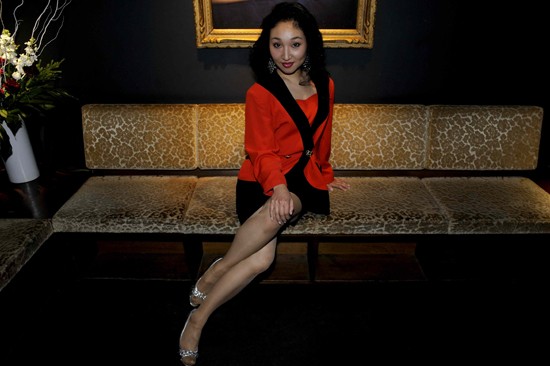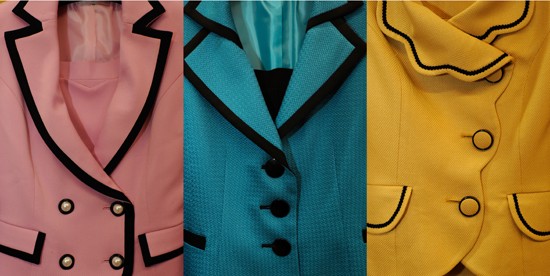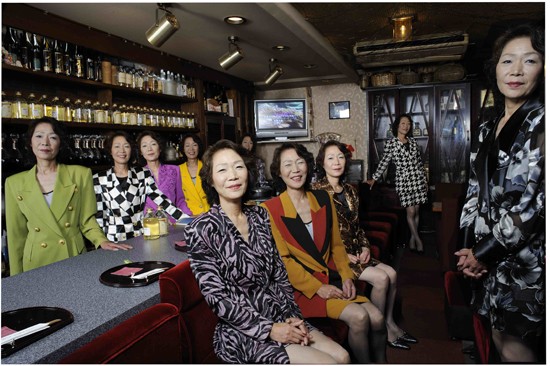Resistance is Futile: The Pulling Power of the ‘Hostess Suit’
On business in the provinces, unenthused about drinking alone in some cramped, cheap hotel room, I hesitantly open the door of a local “snack” establishment. I am no longer young, and no longer intimidated by high-class restaurants of any variety, yet that moment on entering an unfamiliar bar in an unfamiliar town still gives me the jitters.
Indispensable to every such bar is, firstly, a middle-aged Mama-san, followed by booze, a karaoke machine and those suits. I’m talking power-suit shoulder pads, wasp-waisted double-breasted tops, a tantalizing glimpse of a lace bustier and the ubiquitous miniskirt and heels – bold lines and bold colors reminiscent of Gaultier or Thierry Mugler or “body-con” high priest Azzedine Alaïa in the halcyon ’80s, mobilized in a calculated display of bold femininity.

Fashion magazines offer readers a constant diet of high-end labels like Comme des Garçons, and daytime streets teem with Uniqlo and Muji, but after sunset, bars across the nation are still dominated by what we might call “hostess suits” (except at cabaret clubs, where dresses are a more common sight).
Despite this enduring popularity, the fashion media completely ignore the hostess suit, and always have. The nightspots shown in magazines targeting self-styled food and drink aficionados are inevitably venerable establishments staffed by cool, grey-haired bartenders wielding cocktail shakers, or European-style wine bars, or decades-old standing-only drinking dens, but for 90 percent of Japanese adults, the phrase “I’m going drinking tonight” is still synonymous with going to a snack. Thus the invisibility of the ubiquitous hostess suit in the nation’s fashion media parallels the unconscionable absence of guides or magazine features on these popular drinking spots.
According to research conducted by Gaku Nishitani, whose Gifu-based Sobre label supplies hostess suits and dresses to women in nightspots across the nation, Japan was once home to around 300,000 bars, boozers and borderline or blatant brothels and other sellers of sexual services. Ten years ago that figure had fallen to 250,000, and it now stands at 150,000. According to Nishitani, if the trend continues, in three years the figure will drop to 100,000.
While the number of establishments is declining, Nishitani speculates that the industry probably still employs around 750,000 to a million women. So the business of supplying garments to those working in the “water trade” has not been significantly affected. “There’s a market out there worth around 300 billion yen,” he notes. “Which means that each one of those women is spending 300-400,000 yen annually – that’s about two outfits every month.”
The kind of garments usually seen in magazines in fact account for only about 30 percent of the apparel market. The remaining 70 percent consists of “clothing,” as opposed to the “fashion” stocked by department stores, boutiques and multi-label shops. Hostess suits are considered clothing rather than fashion, adds Nishitani. “The height of fashion when they first appeared, now they’re more like what nurses wear: a uniform of sorts.” When you consider the figures, the fashion rags battling for that paltry 30-percent share and killing each other to attract advertisers start to seem somewhat pathetic. Still, they persist despite the fact that not a single magazine deals in the lion’s share of the business – that remaining 70 percent.
Sobre’s suits sell at around 10,000 yen for a three-piece ensemble of jacket, innerwear and skirt. “Even girls with a closet-full have to buy new outfits every month, to keep up appearances among coworkers,” explains Nishitani. The suits are reasonably priced, and made from easy-care, crease-resistant synthetic fabric. And – this is impressive – with a 24-hour call center offering assistance in Japanese, English, Korean and Chinese, there’s no denying the sheer volume of the market.

Strictly speaking, clothing has three purposes, first and foremost for protection against the elements and injury. Next, self-expression – in other words, clothes worn to make a personal statement. And third is clothing designed for the eyes of others – whether to attract or intimidate, such clothes are worn with not the self but someone else in mind. If clothing in fact comes in these three types, the media only cover one: clothing as a means of self-expression, as “fashion.”
Therein no doubt lies the reason for the innate, inevitable tedium of high-fashion garments paraded by interchangeable fashion models devoid of individuality, and the reason too why in Japan’s after-five service industries, which rely on an army of ordinary, pleasure-seeking punters for their very existence, the hostess suit is preferred to any couture creation. Not many women in the entertainment sector would wear the suits out of personal preference. They are a battle dress, donned not for personal gratification but as a manifestation of the desire of patrons to see and drink with girls dressed that way.
According to one of the creators of the hostess suit style, Michiyo Ichihara, a stylist on yakuza films since the late 1980s when Japan basked in economic success before the abrupt reality check that followed, inspiration for the suits did not come from actually canvassing bars to see what women wore. Rather, these were clothes that originated in some nighttime realm of the imagination.
The Mama-sans and girls of places referred to as clubs and bars in fact used to be clad in traditional Japanese attire, or in classic suits and dresses if wearing Western clothing. “Hostess suits” did not even appear in movies until the mid-’80s, and Ichihara for her part only recalls, “That style of clothing appeared around the early ’80s I suppose, influenced by the likes of Vivienne Westwood and Gaultier.” Pulled in at the waist to emphasize the shoulders (for movies, changing the position of buttons and adding shoulder pads to further highlight the shoulder-to-waist ratio), a skirt not too short but with a long slit, tightened to hug the hipline, augmented by high heels, the hostess suit a la Ichihara captured a whiff of the after-dark world through subtle alterations to ready-made garments.
According to Ichihara, a frock would not have made the grade. This was clothing worn at the kind of establishments frequented by company presidents, chairmen and senior gangsters, so it had to be not only sexy, but also decorous, and presentable enough that with a jacket over the top, a girl made a respectable escort. “I suspect the style started with exclusive clubs of that sort in mind,” says Ichihara. Thus the concept behind the hostess suit is one of the titillating promise of a soft center under a hard, businesslike shell, a hint of sex amid seriousness: clever and courteous, yet sensuous.
“Back then, fashion design was dominated by black, black and more black from labels like Comme des Garçons, and the world wasn’t the colorful place it is now,” notes Ichihara. “These days the dividing line between the general public and those working in bars has virtually disappeared; the hostess suit may represent the last era in which the dress of those in nighttime entertainment differed distinctly from that of ‘civilians.'” Perhaps this is what gives hostess suits their unusual quality.
According to Makoto Kurokawa, who runs a club-hostess guide website out of Tokyo’s haut-monde snack neighborhood of Ginza, “Neurological research has shown that men judge a woman with a proportionately slim waist to be ‘of a fertile age,’ and accordingly will seek to have sex with her.” Which, he says, is where the obsession with creating an hourglass effect stems from.
Just as the mainstream cabaret club dresses of today are of a distinctive design developed by taking the ordinary American party dress and modifying it into something more radical and sexy, the high-fashion ladies’ suits of Europe over time underwent a transformation amid neon lights and the aroma of whiskey and soda into this hostess wear peculiar to Japan. It’s a process reminiscent of the way Japan developed high-powered drift-friendly sports cars different to both elegant European supercars and American muscle cars.
But while increasingly teens all over the world rate an S13 or a 180SX (both Nissan Silvias) more covetable than any Porsche or Ferrari, there are as yet no signs of the global fashion media becoming cheerleaders for Japanese bargirl wear. At this rate, designing hostess suits could soon be a lost art. Let’s hope some fashion research institute starts collecting them for posterity before it’s too late.

Even now, as recession deepens and shutters remain shut in local shopping centers, night after night mellifluous sounds beckon from behind bar doors around Japan, including that of Tiger & Rabbit, a snack in Uwajima, Ehime.
The Mama-san here, Kasumi Yamamoto, and I go way back, and on my forays to Uwajima it’s always a pleasure to drop by for an all-night bender. Yamamoto, whose youthful appearance and short skirts belie her 60 years, is invariably clad in a classic example of the hostess suit, and for the purposes of this article I asked her to model a few favorite numbers from her collection. She claimed she was just about to send her winter outfits to the cleaners, and wouldn’t have them back for six months, but I pleaded with her to wait, and choosing to ignore her comment that, to be honest, she preferred black, asked her to share some of her suits, preferably the more vibrant specimens.
The above image is the result. Those cutting-edge shoulder pads recalling the zenith of Gaultier and Mugler, the nipped-in waistlines, the miniskirts just the right length – the authentic hostess suit, nowadays a rare sight, still clings on in places like this. “Mama,” I asked, “Just where do you buy these?” Quick as a flash she replied, “At the Uwajima shops of course, where else!”
In a town of many bars, there used to be several clothing stores in Uwajima catering to women who work at night, but now, Yamamoto laments, hostess suits can no longer be found anywhere. This may be a world where fashion trends hold no sway, but nevertheless it is getting harder to replenish one’s wardrobe. Even a single button lost can never be replaced.
All photos Kyoichi Tsuzuki. ⓒ Kyoichi Tsuzuki.
